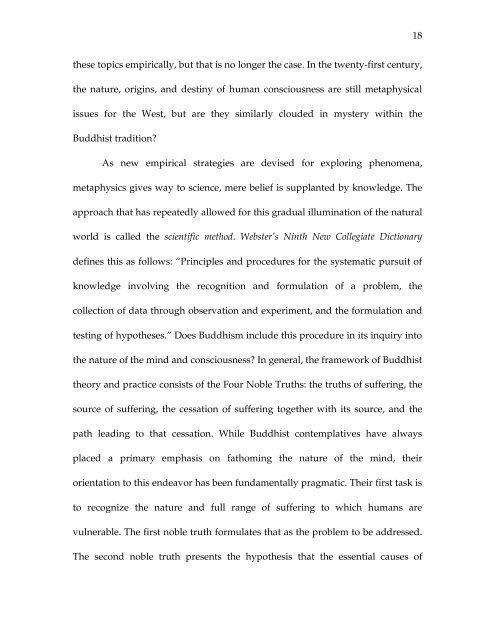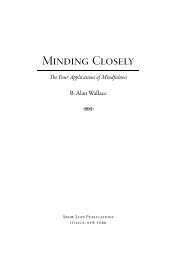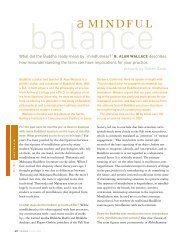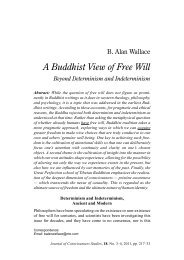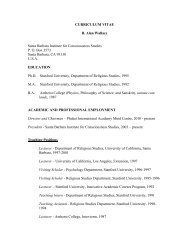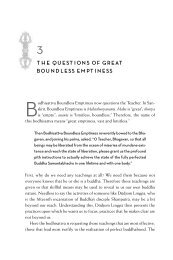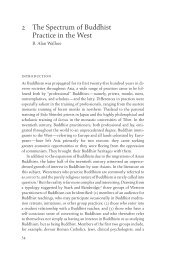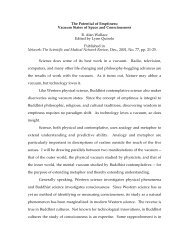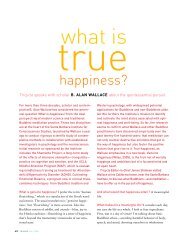“A Science of Consciousness: Buddhism (1), the ... - B. Alan Wallace
“A Science of Consciousness: Buddhism (1), the ... - B. Alan Wallace
“A Science of Consciousness: Buddhism (1), the ... - B. Alan Wallace
Create successful ePaper yourself
Turn your PDF publications into a flip-book with our unique Google optimized e-Paper software.
<strong>the</strong>se topics empirically, but that is no longer <strong>the</strong> case. In <strong>the</strong> twenty-first century,<br />
<strong>the</strong> nature, origins, and destiny <strong>of</strong> human consciousness are still metaphysical<br />
issues for <strong>the</strong> West, but are <strong>the</strong>y similarly clouded in mystery within <strong>the</strong><br />
Buddhist tradition?<br />
As new empirical strategies are devised for exploring phenomena,<br />
metaphysics gives way to science, mere belief is supplanted by knowledge. The<br />
approach that has repeatedly allowed for this gradual illumination <strong>of</strong> <strong>the</strong> natural<br />
world is called <strong>the</strong> scientific method. Webster’s Ninth New Collegiate Dictionary<br />
defines this as follows: “Principles and procedures for <strong>the</strong> systematic pursuit <strong>of</strong><br />
knowledge involving <strong>the</strong> recognition and formulation <strong>of</strong> a problem, <strong>the</strong><br />
collection <strong>of</strong> data through observation and experiment, and <strong>the</strong> formulation and<br />
testing <strong>of</strong> hypo<strong>the</strong>ses.” Does <strong>Buddhism</strong> include this procedure in its inquiry into<br />
<strong>the</strong> nature <strong>of</strong> <strong>the</strong> mind and consciousness? In general, <strong>the</strong> framework <strong>of</strong> Buddhist<br />
<strong>the</strong>ory and practice consists <strong>of</strong> <strong>the</strong> Four Noble Truths: <strong>the</strong> truths <strong>of</strong> suffering, <strong>the</strong><br />
source <strong>of</strong> suffering, <strong>the</strong> cessation <strong>of</strong> suffering toge<strong>the</strong>r with its source, and <strong>the</strong><br />
path leading to that cessation. While Buddhist contemplatives have always<br />
placed a primary emphasis on fathoming <strong>the</strong> nature <strong>of</strong> <strong>the</strong> mind, <strong>the</strong>ir<br />
orientation to this endeavor has been fundamentally pragmatic. Their first task is<br />
to recognize <strong>the</strong> nature and full range <strong>of</strong> suffering to which humans are<br />
vulnerable. The first noble truth formulates that as <strong>the</strong> problem to be addressed.<br />
The second noble truth presents <strong>the</strong> hypo<strong>the</strong>sis that <strong>the</strong> essential causes <strong>of</strong><br />
18


